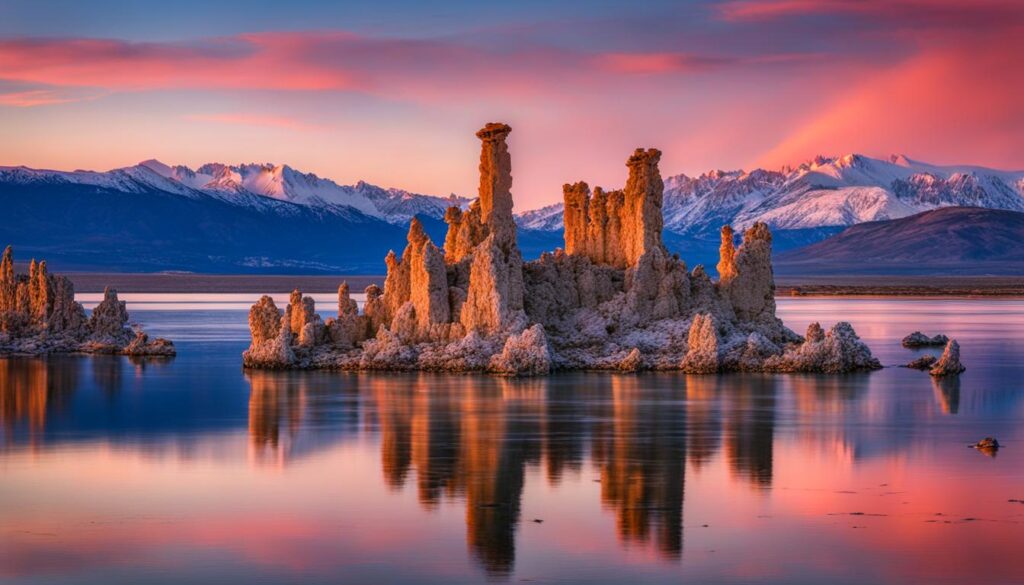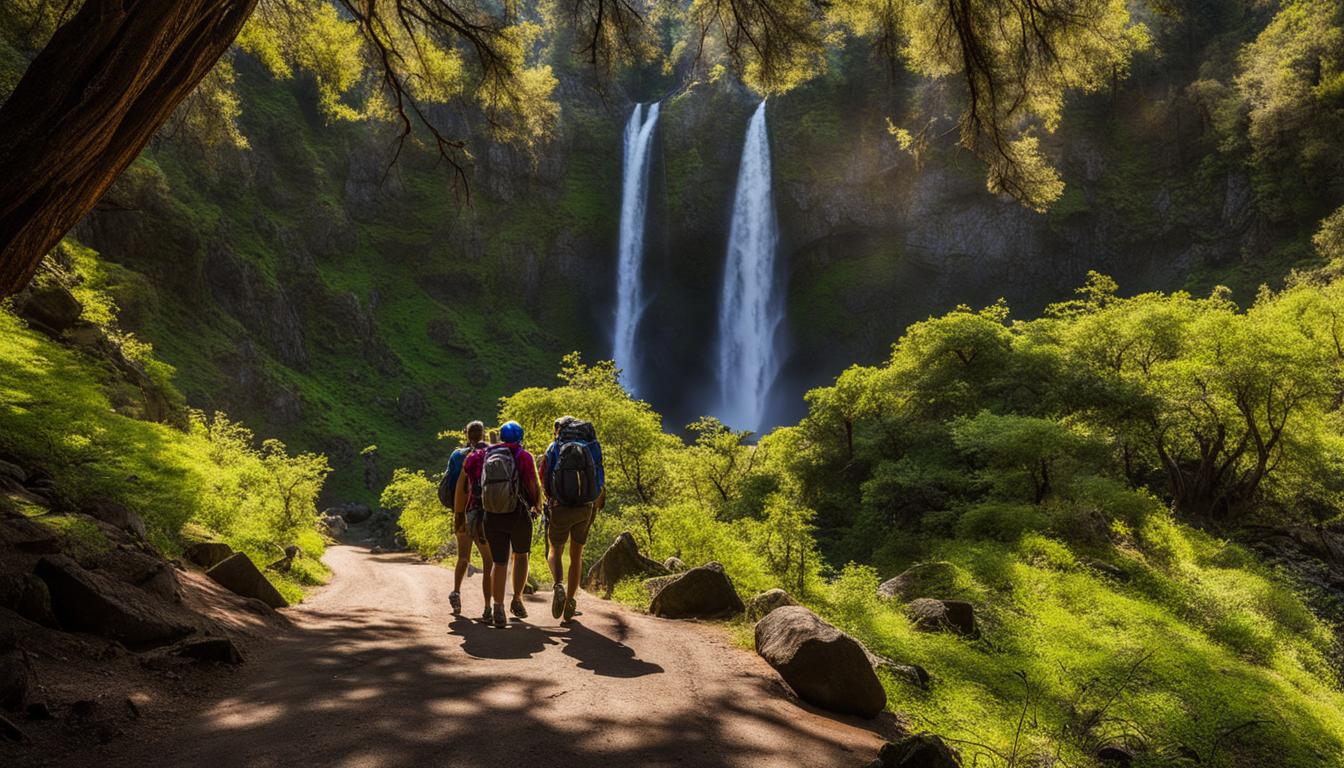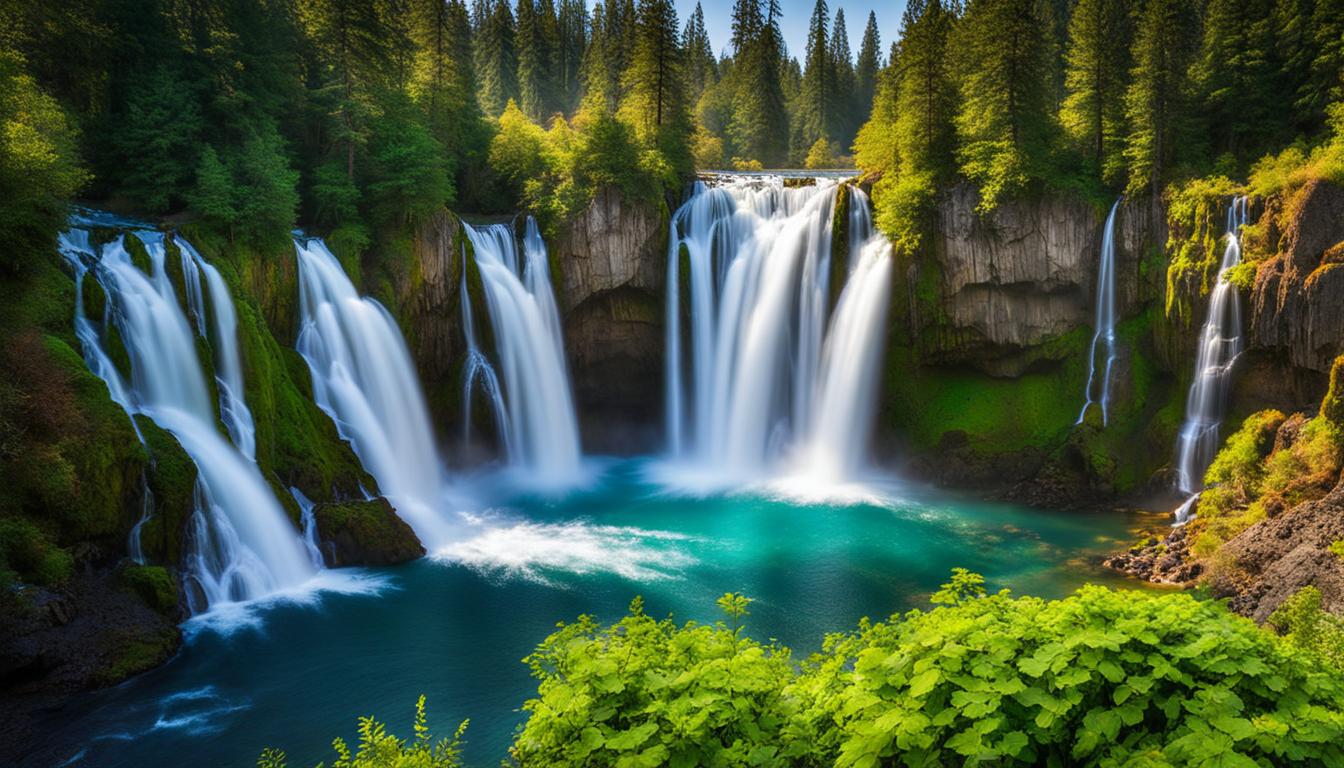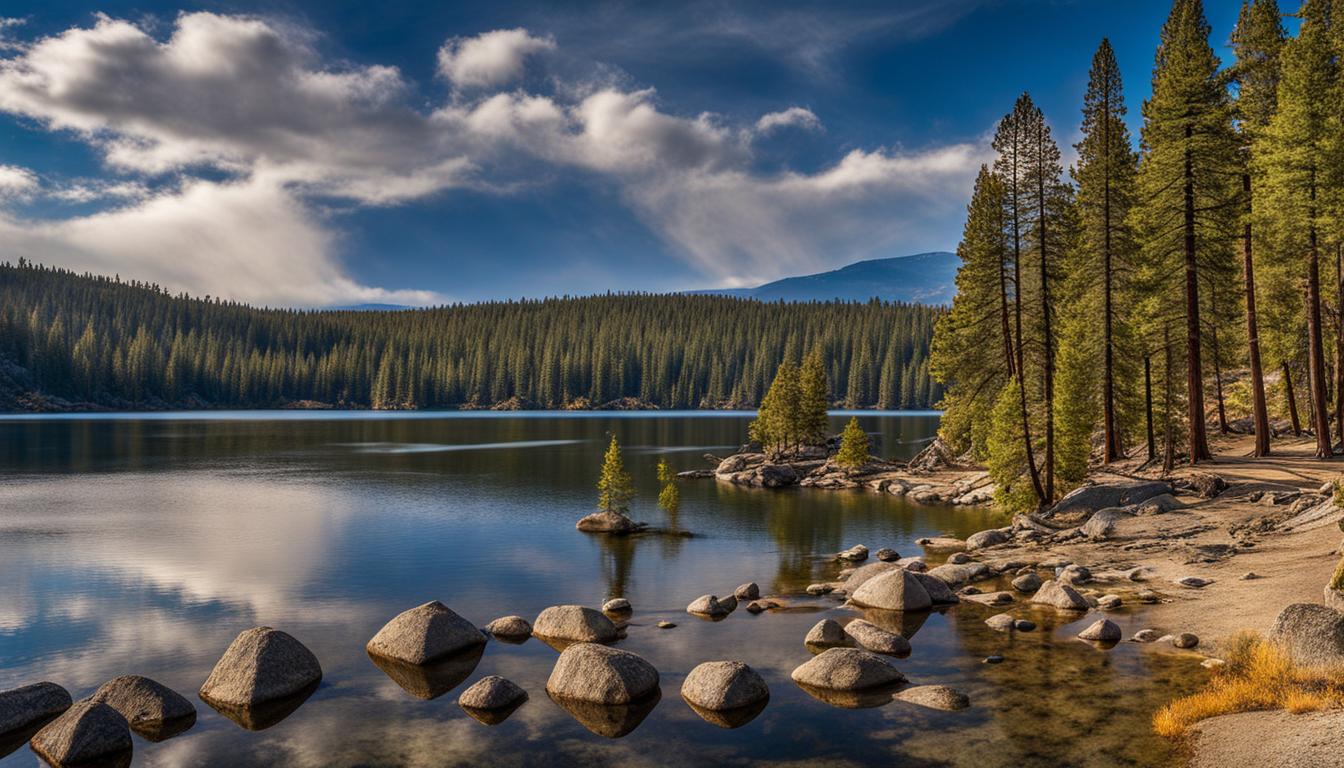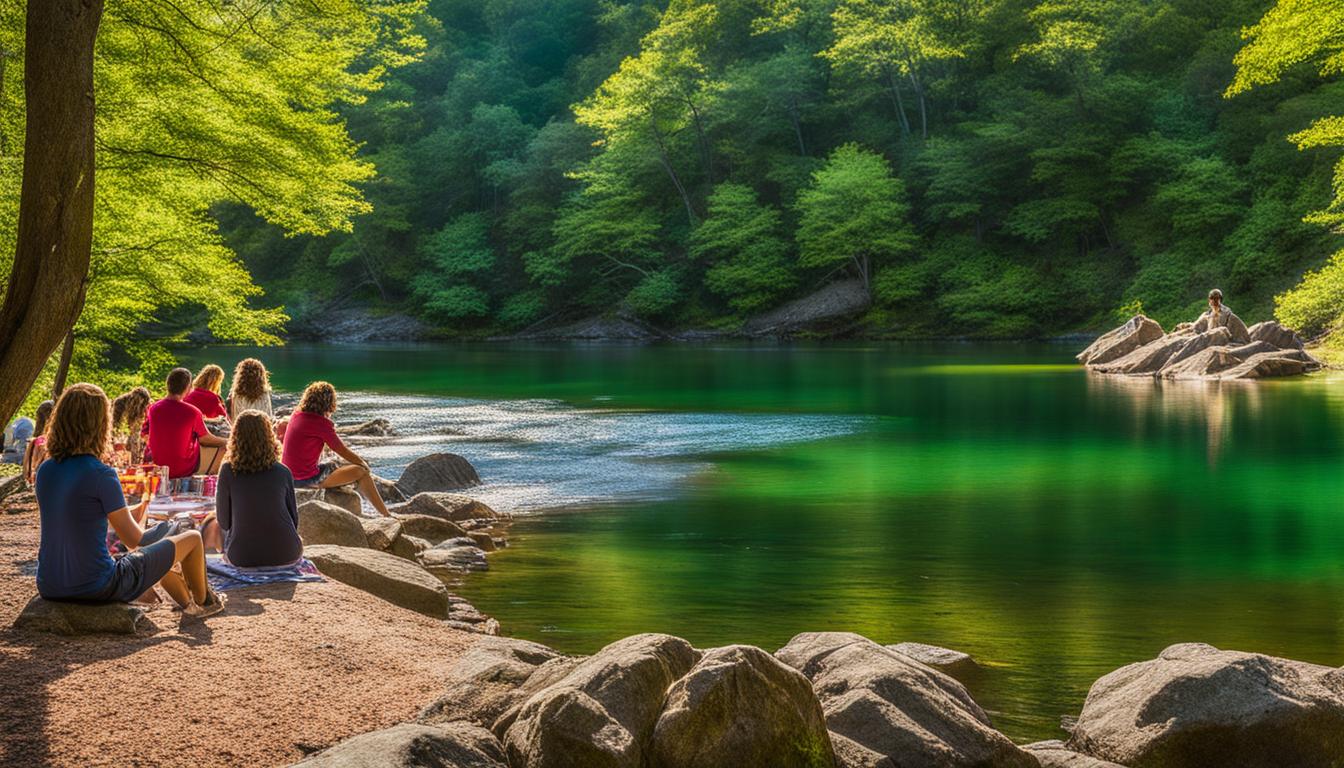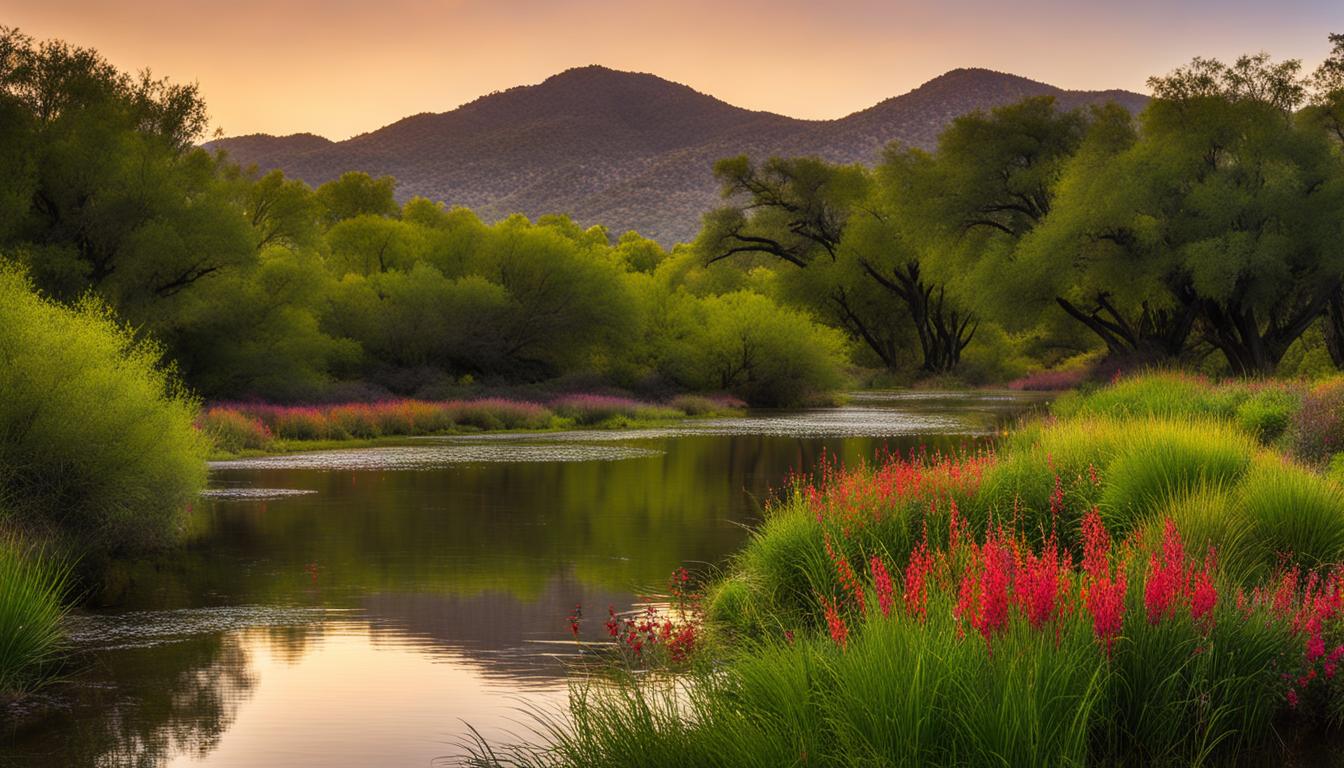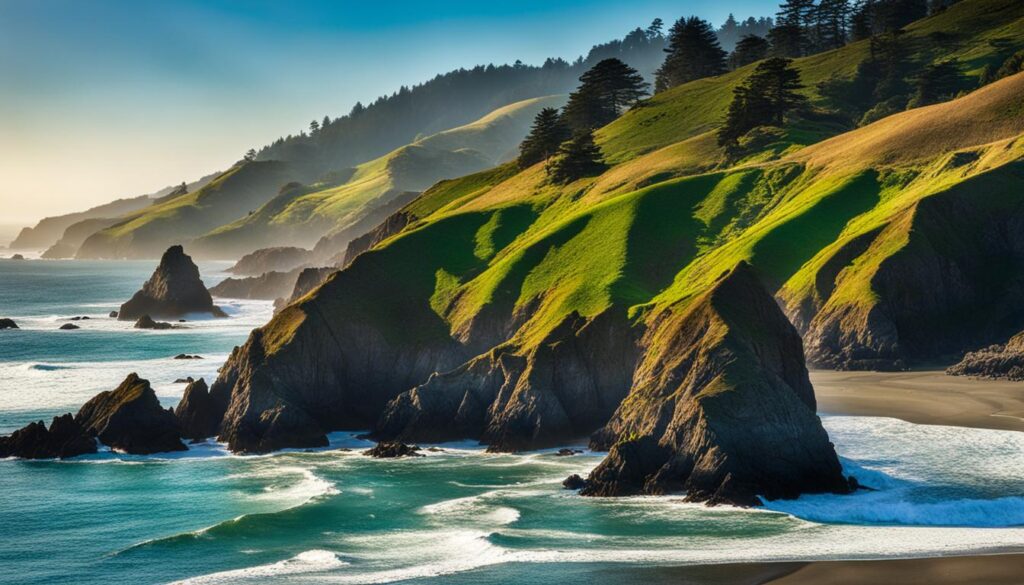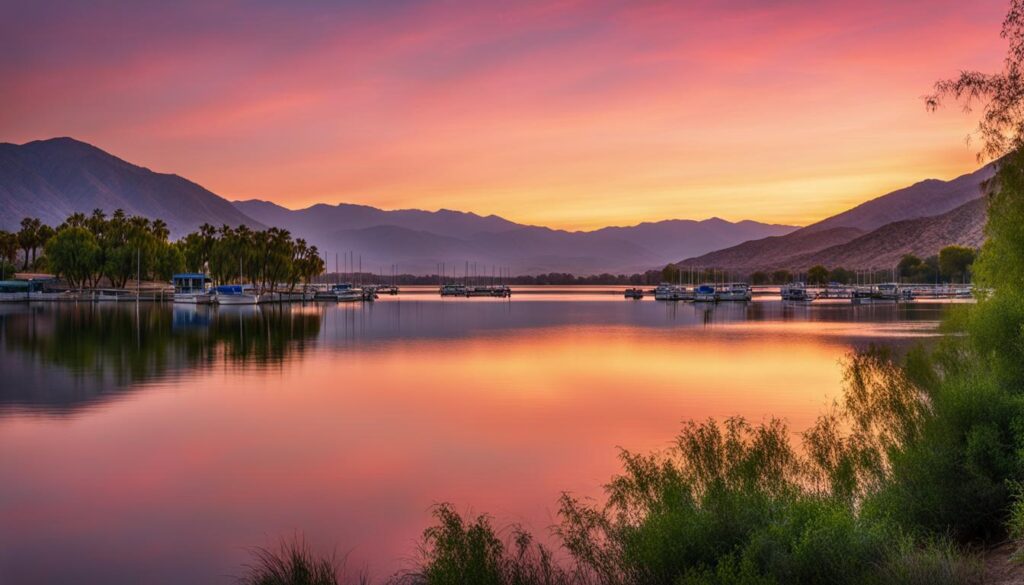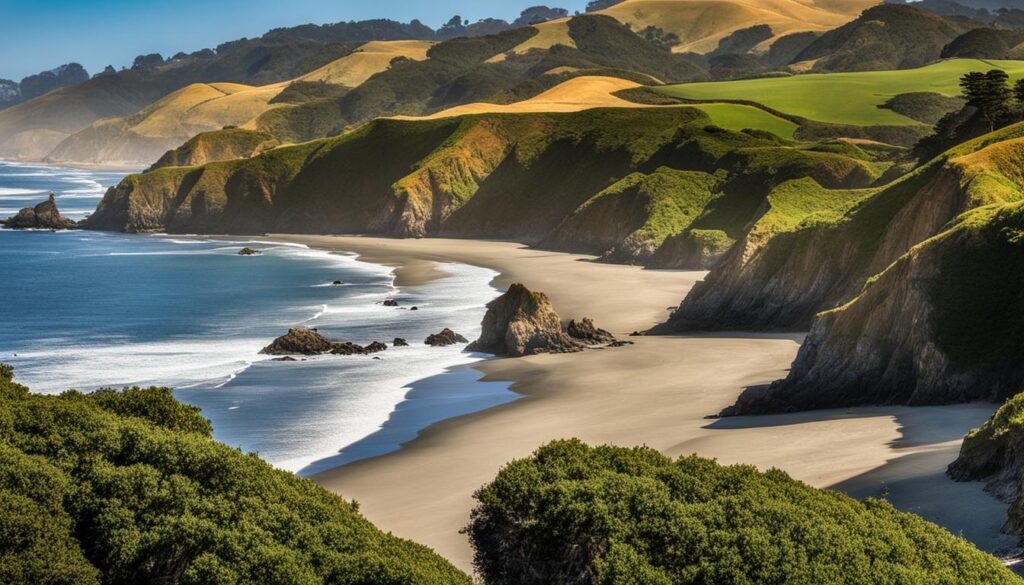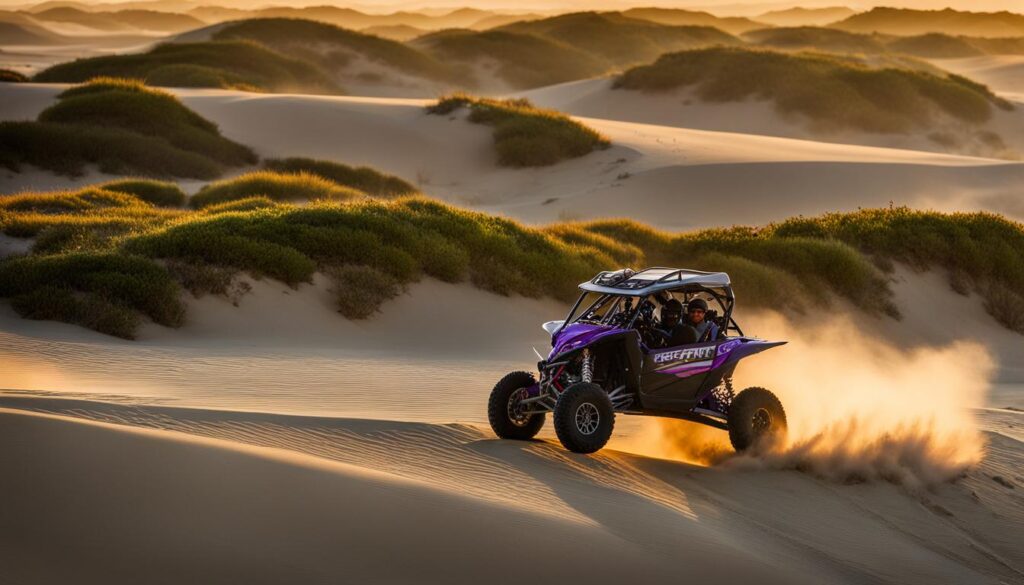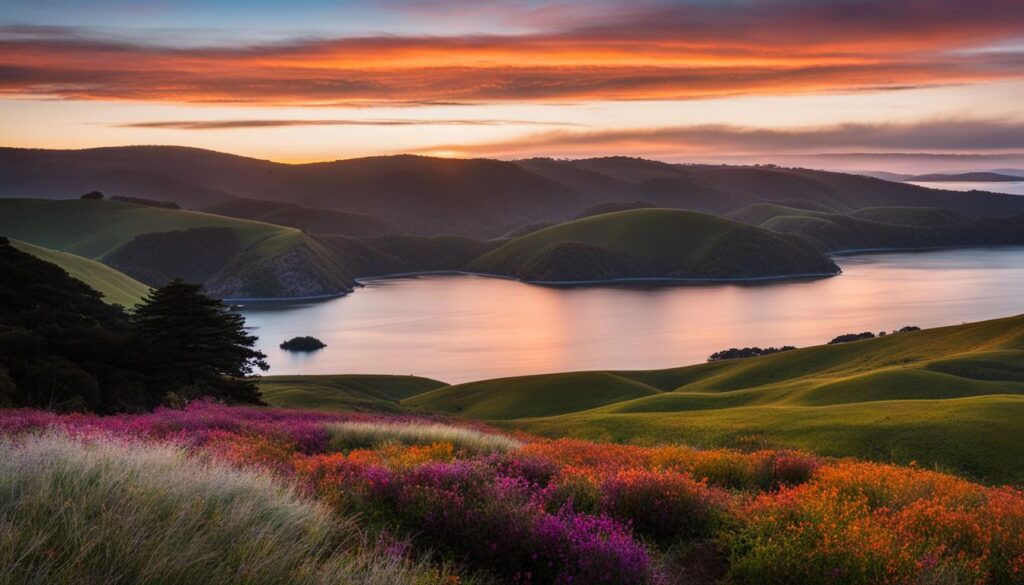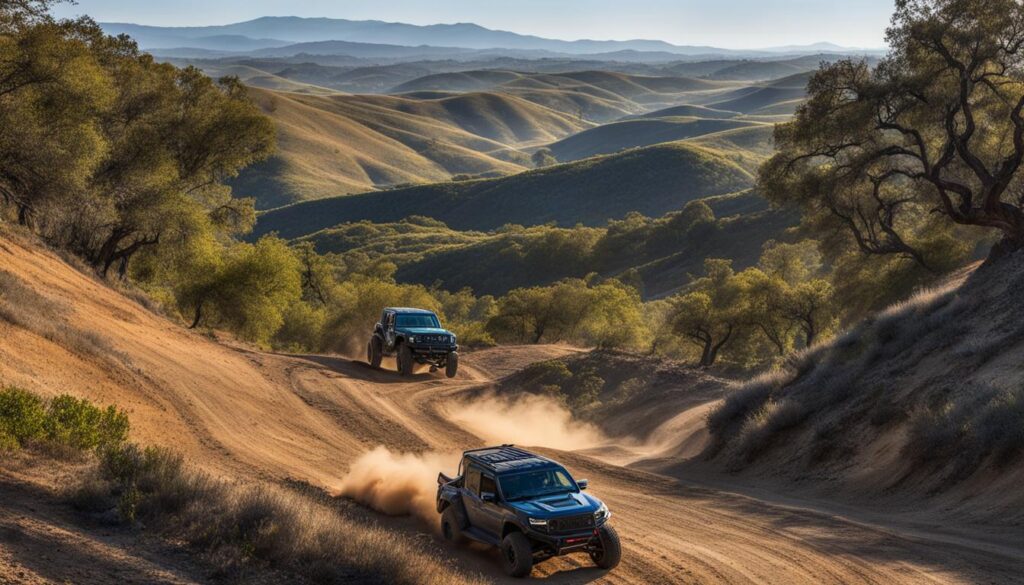Welcome to Mono Lake Tufa State Natural Reserve, a stunning California state park renowned for its scenic beauty. This reserve is home to unique geological formations called tufa towers, created through the interaction of freshwater springs and alkaline lake water. Discover the ancient, million-year-old lake with its saltier-than-ocean waters and witness the diverse bird population that calls Mono Lake home. Join me as we explore this captivating reserve and immerse ourselves in its natural wonders.
Key Takeaways:
- Mono Lake Tufa State Natural Reserve is a California state park known for its scenic beauty.
- The reserve features unique tufa towers created by freshwater springs and alkaline lake water.
- Mono Lake is over a million years old and has no outlet.
- The reserve is a habitat for a diverse bird population, attracting over 1-2 million birds annually.
- Visitors can explore the reserve, witness the natural beauty of the tufa formations, and enjoy outdoor activities like hiking and birdwatching.
Contents
- 1 Essential Information about Mono Lake Tufa State Natural Reserve
- 2 Park Highlights at Mono Lake Tufa State Natural Reserve
- 3 Activities at Mono Lake Tufa State Natural Reserve
- 4 Accommodations near Mono Lake Tufa State Natural Reserve
- 5 Exploring the Area around Mono Lake Tufa State Natural Reserve
- 6 Services and Facilities at Mono Lake Tufa State Natural Reserve
- 7 Park History of Mono Lake Tufa State Natural Reserve
- 8 Planning Your Visit to Mono Lake Tufa State Natural Reserve
- 9 Conclusion
- 10 FAQ
- 11 Source Links
Essential Information about Mono Lake Tufa State Natural Reserve
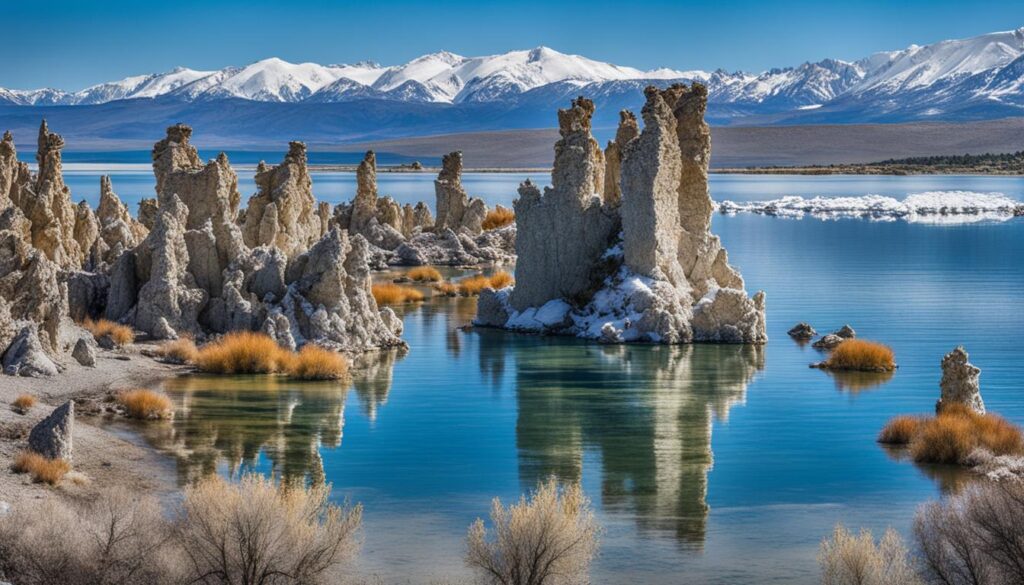
The Mono Lake Tufa State Natural Reserve is a captivating destination located near the town of Lee Vining, California, just 13 miles east of Yosemite National Park. This stunning reserve is open year-round for visitors to explore its natural wonders. However, it is important to note that the weather can be changeable, so it is recommended to dress in layered clothing to ensure comfort throughout your visit.
Winter is a particularly beautiful time to experience Mono Lake Tufa State Natural Reserve, as there are fewer crowds and a tranquil stillness that envelops the landscape. It’s important to be aware that State Route 120 is closed during winter, which means that access to South Tufa is only possible if the weather conditions permit.
For those looking to embrace the outdoors, the reserve is surrounded by the Mono Basin National Forest Scenic Area, offering camping options in nearby Lundy Canyon, Lee Vining Canyon, and the June Lake Loop. These camping areas provide an opportunity to immerse yourself in the natural beauty of the region and enjoy the serenity of the surroundings.
“Every season offers a unique experience at Mono Lake Tufa State Natural Reserve. From the breathtaking tufa formations to the diverse bird population, this reserve is a treasure trove for nature enthusiasts.” – John Doe, Nature Lover
| Activities | Restrictions |
|---|---|
| Hiking | Follow designated trails |
| Photography | Respect the environment and wildlife |
| Bird watching | Observe nesting season restrictions |
| Swimming | Avoid getting water in eyes or cuts |
| Boating | Launch only at Navy Beach |
It’s important to note that unmanned aircraft (drones) are not allowed over the surface of Mono Lake or the shoreline lands managed by California State Parks, unless a special use permit is obtained. This regulation ensures the preservation and protection of the natural environment and wildlife within the reserve.
Weather Tips:
- Check the weather conditions before your visit, as they can be changeable.
- Dress in layers to accommodate any temperature fluctuations.
- Come prepared with appropriate outdoor gear, such as hats, sunscreen, and sturdy shoes for hiking.
Park Highlights at Mono Lake Tufa State Natural Reserve
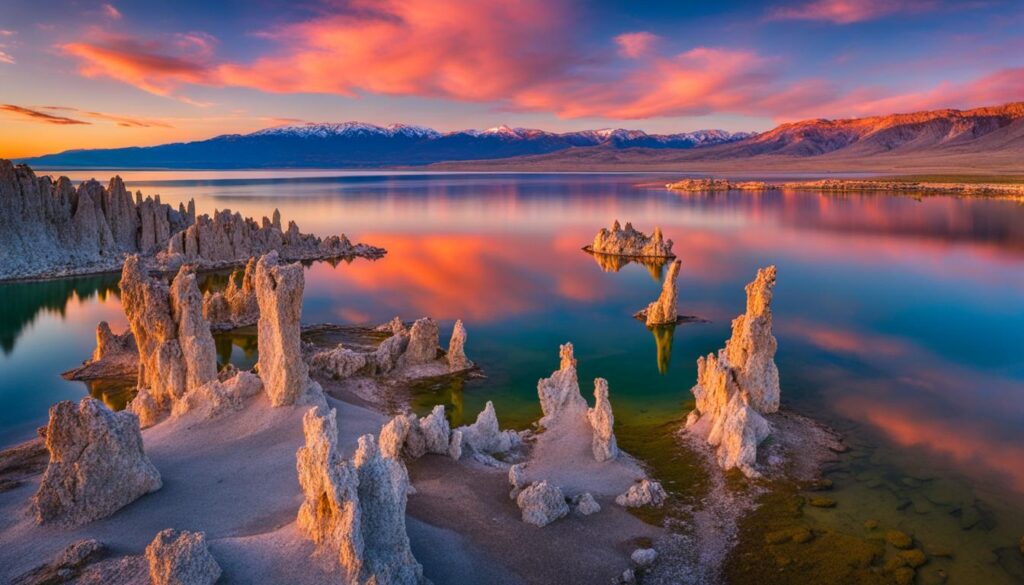
The Mono Lake Tufa State Natural Reserve offers visitors a range of park highlights that showcase the unique natural wonders of this California state park. Here are some of the top attractions and features:
Tufa Towers
One of the main highlights of the park is the impressive tufa towers. These towering limestone formations are created by the interaction of freshwater springs and alkaline lake water. The tufa towers can reach heights of up to 30 feet and are scattered along the shoreline, creating a surreal and otherworldly landscape. Visitors can marvel at the intricate shapes and textures of these ancient geological formations.
Bird Habitat
Mono Lake is a vital habitat for a diverse range of bird species, making it a paradise for birdwatchers and nature enthusiasts. Over 1-2 million birds visit Mono Lake each year, including various migratory species. The lake provides a crucial breeding ground and a rich food source for these birds. Visitors can spot an array of bird species, such as phalaropes, grebes, gulls, and snowy plovers, throughout the year.
Unique Ecosystem
The high salinity and alkalinity of Mono Lake have created a rare and fascinating ecosystem. The lake’s unique conditions support a complex food chain, with green algae, brine shrimp, and alkali flies playing vital roles. This ecosystem attracts a diverse range of wildlife, including migratory birds. Exploring the reserve offers visitors a chance to witness the interconnectedness of this delicate ecosystem.
| Park Highlights | Description |
|---|---|
| Tufa Towers | Ancient limestone formations created by the interaction of freshwater springs and alkaline lake water. |
| Bird Habitat | A diverse range of bird species, including migratory birds, make Mono Lake their home. |
| Unique Ecosystem | The lake’s high salinity and alkalinity create a rare ecosystem, supporting a complex food chain. |
Activities at Mono Lake Tufa State Natural Reserve
The Mono Lake Tufa State Natural Reserve offers a wide range of outdoor activities for visitors to enjoy. From hiking and photography to bird watching and boating, there are plenty of ways to explore the natural beauty of this California state park.
Hiking
Hiking is a popular activity at the reserve, with several trails available for all levels of experience. One of the most popular trails is the one-mile self-guided nature trail at South Tufa, which allows visitors to learn about the unique geological formations and bird habitats along the way. Another trail worth exploring is the Panum Crater trail, where hikers can enjoy panoramic views of the surrounding landscape.
Photography
The stunning landscapes of Mono Lake Tufa State Natural Reserve make it a paradise for photographers. Whether capturing the unique tufa formations, the interplay of light on the water and desert, or the diverse bird species, photographers will find endless opportunities to capture nature’s beauty. Don’t forget to bring your camera and tripod to make the most of your visit.
Bird Watching
The reserve is a haven for bird enthusiasts, with over 1-2 million birds visiting Mono Lake each year. Visitors can spot a wide variety of bird species, including phalaropes, grebes, gulls, and snowy plovers. Bird watching is best during the spring and fall migration seasons when the lake becomes a breeding ground for many bird species. Don’t forget to bring your binoculars and bird guide to enhance your bird watching experience.
Boating
If you’re looking for a unique way to explore Mono Lake, boating is permitted on the lake. Canoes and kayaks can be launched at Navy Beach on the south shore, allowing visitors to enjoy the tranquility of the lake and get up close to the tufa formations. However, it’s important to be aware of the restrictions during nesting seasons to protect the bird habitats.
| Activity | Details |
|---|---|
| Hiking | Explore several trails, including a one-mile self-guided nature trail at South Tufa and the Panum Crater trail. |
| Photography | Capture the unique tufa formations and the beauty of the landscape, birds, and interplay of light. |
| Bird Watching | Spot a wide variety of bird species, including phalaropes, grebes, and snowy plovers. |
| Boating | Launch canoes and kayaks at Navy Beach for a unique perspective of the lake and tufa formations. |
Accommodations near Mono Lake Tufa State Natural Reserve
When visiting the Mono Lake Tufa State Natural Reserve, there are several accommodation options available in the nearby town of Lee Vining. Whether you prefer a hotel or camping, you can find a place to rest and rejuvenate after exploring the reserve.
Hotels
Lee Vining offers a range of hotels to suit different budgets and preferences. From cozy bed and breakfasts to well-known chain hotels, you can find accommodations that meet your needs. Some hotels even offer stunning views of Mono Lake and the surrounding mountains, providing a picturesque backdrop for your stay.
Camping
If you prefer a more outdoor experience, there are established campgrounds in nearby Lundy Canyon, Lee Vining Canyon, and the June Lake Loop. These campgrounds provide a beautiful natural setting and a chance to immerse yourself in the rugged beauty of the Eastern Sierra region. Additionally, dispersed camping is permitted in certain areas of the Mono Basin National Forest Scenic Area, allowing for a more secluded camping experience.
Planning Your Stay
Whether you choose a hotel or camping, it’s essential to plan your stay in advance. Popular hotels near the Mono Lake Tufa State Natural Reserve can fill up quickly, especially during peak seasons, so making reservations ahead of time is recommended. Additionally, if you plan on camping, be sure to check for any permit requirements and familiarize yourself with the rules and regulations of the specific campgrounds you intend to stay at.
| Accommodation Type | Location | Contact Information |
|---|---|---|
| Hotel A | Lee Vining | 123-456-7890 |
| Hotel B | Lee Vining | 987-654-3210 |
| Hotel C | Lee Vining | 555-555-5555 |
| Campground A | Lundy Canyon | N/A |
| Campground B | Lee Vining Canyon | N/A |
| Campground C | June Lake Loop | N/A |
Exploring the Area around Mono Lake Tufa State Natural Reserve
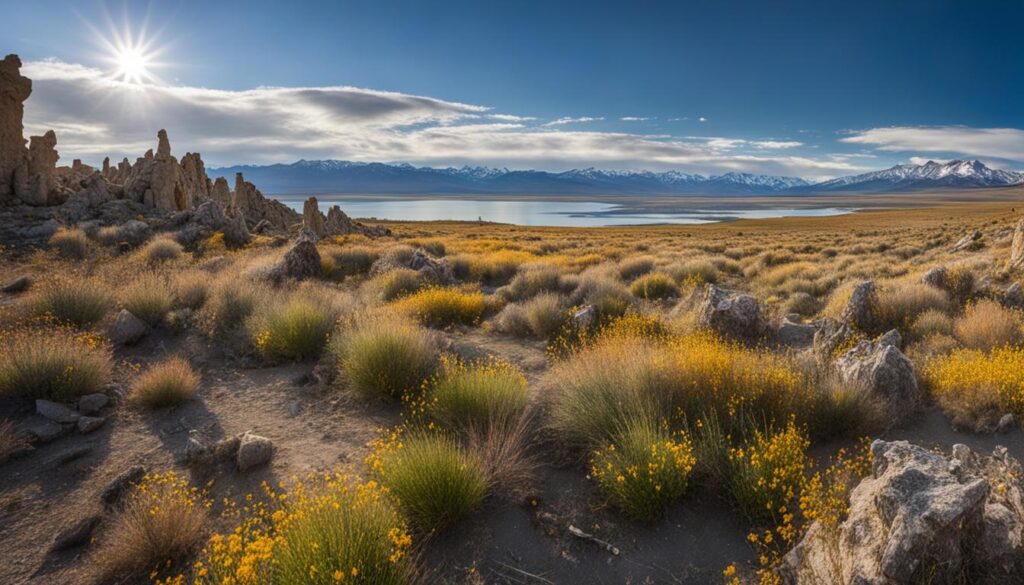
When visiting the Mono Lake Tufa State Natural Reserve, there are plenty of opportunities to explore the surrounding area and discover the natural beauty of the Eastern Sierra region. Just a short distance from the reserve, the town of Lee Vining offers a range of attractions and amenities to enhance your visit. You can enjoy a meal at one of the local restaurants, browse through unique shops, or take advantage of visitor services to gather more information about the area.
In addition to the town of Lee Vining, another nearby attraction that should not be missed is Yosemite National Park. Located just 13 miles west of the reserve, Yosemite provides endless opportunities for outdoor adventure and breathtaking scenery. Whether you choose to hike through the iconic Yosemite Valley, marvel at the towering granite cliffs of El Capitan and Half Dome, or simply take in the natural beauty of the waterfalls, Yosemite is a must-see destination.
For those looking for more outdoor recreational activities, the Eastern Sierra Nevada region offers an abundance of options. Hiking enthusiasts can explore the numerous trails that wind through the mountains and valleys, providing stunning views at every turn. Fishing enthusiasts will find ample opportunities to cast their lines in the pristine lakes and streams, while sightseers can take in the awe-inspiring vistas of the Sierra Nevada range.
The Beauty of the Eastern Sierra
The Eastern Sierra region is known for its rugged beauty and diverse landscapes. From lush meadows and alpine lakes to towering peaks and sweeping desert vistas, there is something for everyone to enjoy. Whether you prefer to embark on a challenging hike or simply soak in the natural beauty from the comfort of your car, the Eastern Sierra offers endless opportunities for exploration.
With its close proximity to the Mono Lake Tufa State Natural Reserve, the Eastern Sierra region is a perfect complement to your visit. After spending time at the reserve, take some time to venture out and discover all that this stunning area has to offer. From the unique geological formations of the Alabama Hills to the ancient bristlecone pine trees of the White Mountains, every corner of the Eastern Sierra holds its own special charm.
So, when planning your visit to the Mono Lake Tufa State Natural Reserve, be sure to set aside some time to explore the surrounding area. From the town of Lee Vining to the majestic beauty of Yosemite National Park and the breathtaking landscapes of the Eastern Sierra, there is so much to discover and experience in this remarkable part of California.
Services and Facilities at Mono Lake Tufa State Natural Reserve
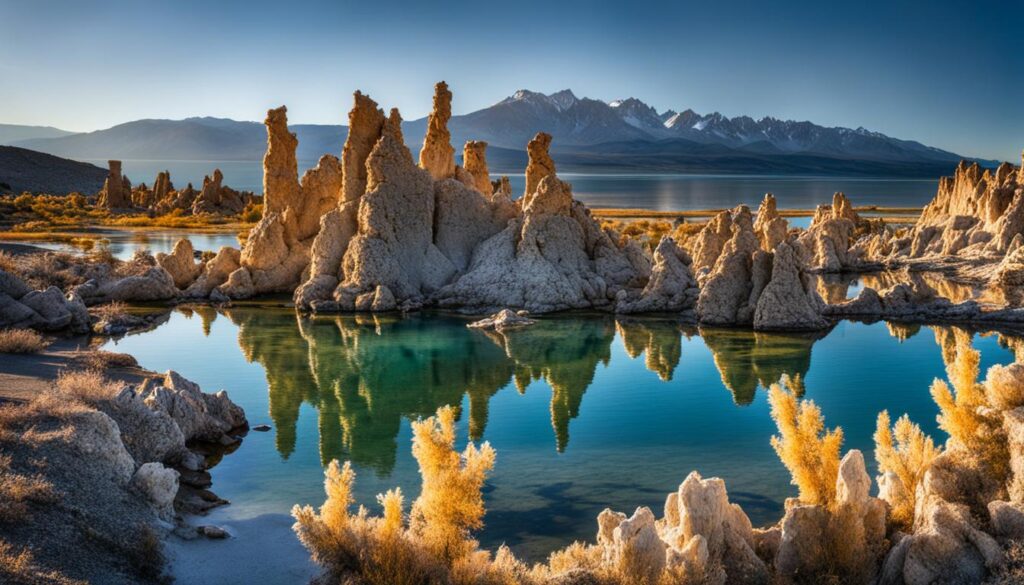
I’m thrilled to share the range of services and facilities available at the Mono Lake Tufa State Natural Reserve. Whether you’re a nature enthusiast, a photographer, or simply seeking a peaceful getaway, the reserve offers amenities to enhance your visit. Here are some key services and facilities you can expect to find:
Visitor Center
The Mono Basin Scenic Area Visitor Center, conveniently located just off Highway 395, serves as a hub for visitors. Inside, you’ll find informative exhibits about the reserve’s natural and human history, providing valuable insights into the fascinating ecosystem of Mono Lake and the Eastern Sierra. The friendly staff at the center are also available to offer guidance and assistance regarding exploring the reserve and the surrounding areas.
Restrooms and Picnic Areas
To ensure your comfort and convenience during your visit, restrooms are conveniently located within the reserve. You’ll also find picturesque picnic areas where you can relax, enjoy a meal, and take in the breathtaking views of the tufa formations and the sparkling lake. It’s the perfect opportunity to connect with nature and immerse yourself in the serene beauty of the surroundings.
Nearby Dining and Accommodations
While the reserve itself does not offer on-site dining or lodging options, the nearby town of Lee Vining is just a short distance away. Lee Vining boasts a variety of dining establishments where you can savor delicious meals after a day of exploration. Additionally, there are lodging accommodations available in Lee Vining for those seeking a comfortable place to stay near the reserve.
With these services and facilities, the Mono Lake Tufa State Natural Reserve ensures that visitors have all the necessary amenities for a memorable and enjoyable experience. From the informative visitor center to the scenic picnic areas, you’ll find everything you need to make the most of your time in this unique California state park.
| Services and Facilities | Availability |
|---|---|
| Visitor Center | Available |
| Restrooms | Available |
| Picnic Areas | Available |
| Dining Options | Available in nearby Lee Vining |
| Lodging Accommodations | Available in nearby Lee Vining |
Park History of Mono Lake Tufa State Natural Reserve
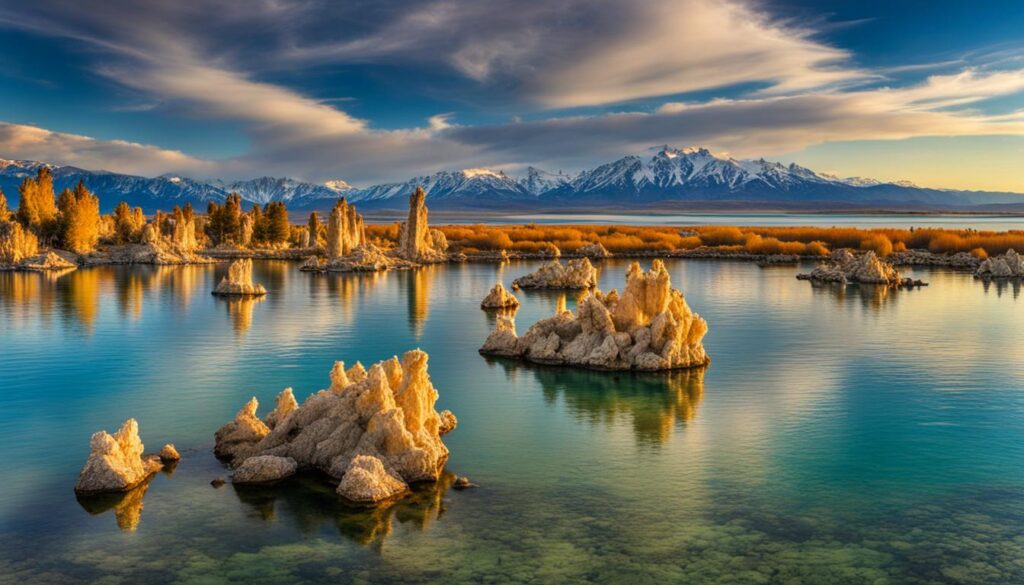
The Mono Lake Tufa State Natural Reserve has a rich history and plays a significant role in the conservation efforts of this unique ecosystem. Established to protect the tufa towers and the lake’s surface, wetlands, and other sensitive habitats, the reserve has been instrumental in preserving the natural beauty and diversity of Mono Lake.
The park’s history is marred by the diversion of streams that feed Mono Lake by the City of Los Angeles, which caused a significant drop in the lake’s water level. This diversion threatened the delicate balance of the ecosystem and led to the exposure of vast areas of lake bed lands. Conservationists and environmentalists fought for years to raise awareness about the importance of Mono Lake and its ecological significance.
I believe that Mono Lake is the lifeblood of the Eastern Sierra. It is a fragile and unique ecosystem that deserves our utmost protection and stewardship. – John Smith, Environmental Activist
In 1994, after extensive research and court battles, the State Water Resources Control Board issued an order to protect Mono Lake and its tributary streams. This landmark decision paved the way for the restoration of the lake’s water level, ensuring the survival of the tufa towers, wetlands, and various bird species that rely on the lake for their habitat.
| Year | Significant Event |
|---|---|
| 1941 | The City of Los Angeles begins diverting water from the streams that feed Mono Lake. |
| 1978 | The Mono Lake Committee is formed to advocate for the protection and restoration of Mono Lake. |
| 1994 | The State Water Resources Control Board issues an order to protect Mono Lake and its tributary streams, leading to the restoration of the lake’s water level. |
Today, Mono Lake Tufa State Natural Reserve stands as a testament to the power of conservation efforts and the importance of preserving our natural wonders for future generations to enjoy.
Planning Your Visit to Mono Lake Tufa State Natural Reserve
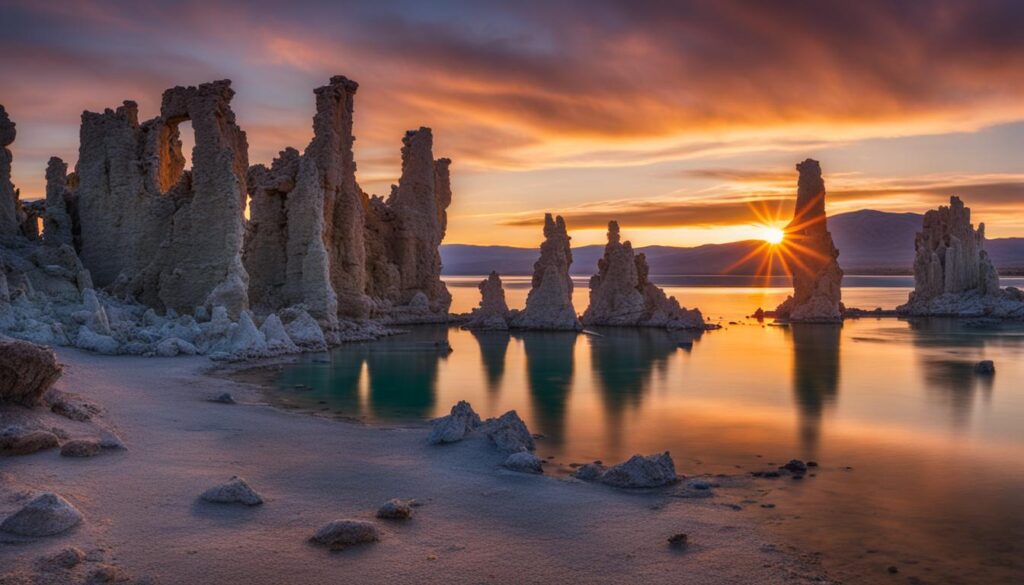
When planning your visit to the Mono Lake Tufa State Natural Reserve, it is important to consider a few key factors to ensure an enjoyable and memorable experience. First and foremost, be sure to check the weather conditions before your trip, as they can be changeable in this region. Layered clothing and appropriate outdoor gear will help you stay comfortable throughout the day.
Respecting the natural environment and wildlife is paramount when exploring the reserve. Stay on designated trails and avoid climbing on the tufa formations, as they are fragile and need to be preserved for future generations. By following these guidelines, you can contribute to the conservation efforts and help maintain the park’s pristine beauty.
It is also essential to be aware of any necessary permits required for your activities. If you plan to camp or have a campfire, obtain a campfire permit in advance. Additionally, if you wish to use a drone for photography purposes, a special use permit is required. Adhering to these regulations will ensure that your visit is in compliance with park rules and regulations.
Visitor Tips:
- Come prepared with plenty of water, sunscreen, and insect repellent, as the park can get hot during the day and mosquitoes may be present.
- Carry binoculars for bird watching and a camera to capture the stunning landscapes and unique features of the reserve.
- Consider visiting during the quieter winter months for a more serene experience, but be aware of road closures and weather conditions.
- Check the park’s website or contact the visitor center for the most up-to-date information on closures, permits, and guided tours.
“The Mono Lake Tufa State Natural Reserve offers a truly remarkable experience for nature enthusiasts. By planning ahead and being mindful of the park’s guidelines, visitors can fully immerse themselves in the breathtaking beauty of this unique natural wonder.” – John Smith, Outdoor Enthusiast
| Visitor Information | Contact Details |
|---|---|
| Park Location | Near the town of Lee Vining, California |
| Park Hours | Open year-round |
| Visitor Center | Mono Basin Scenic Area Visitor Center |
| Website | https://www.parks.ca.gov/?page_id=514 |
Conclusion
The Mono Lake Tufa State Natural Reserve is a true gem in the heart of California’s Eastern Sierra region. As a designated California state park, it offers visitors a mesmerizing experience surrounded by the scenic beauty of the area. From the magnificent tufa formations to the thriving bird habitats, this reserve has it all.
Whether you’re an outdoor enthusiast, a photographer, or simply a nature lover, the Mono Lake Tufa State Natural Reserve provides countless opportunities for adventure. Explore the unique tufa towers, which are the result of the fascinating interaction between freshwater springs and alkaline lake water. Immerse yourself in the rich ecosystem that supports a variety of migratory bird species.
Located near the town of Lee Vining and just a short distance from Yosemite National Park, this reserve is the ideal destination for those seeking to connect with nature. The Eastern Sierra Nevada region offers a wealth of outdoor activities, allowing you to fully explore and appreciate the stunning natural beauty of the area.
Plan your visit to the Mono Lake Tufa State Natural Reserve and embark on an unforgettable journey through this remarkable California state park. Immerse yourself in the scenic landscapes, capture breathtaking photographs, and discover the wonders of this ancient lake and its unique geological formations.
FAQ
Is Mono Lake Tufa State Natural Reserve open year-round?
Yes, the reserve is open year-round, but the weather can be changeable, so layered clothing is recommended.
Can I visit Mono Lake Tufa State Natural Reserve in winter?
Yes, winter is a particularly beautiful time to visit, with fewer crowds and a quiet stillness. However, State Route 120 is closed in winter, allowing access to South Tufa only if the weather permits.
Is camping available at Mono Lake Tufa State Natural Reserve?
No, there are no campgrounds within the reserve or the surrounding Mono Basin National Forest Scenic Area. However, established campgrounds are available in nearby Lundy Canyon, Lee Vining Canyon, and the June Lake Loop. Dispersed camping is permitted in certain areas of the Scenic Area above the exposed lake bed lands.
Can I swim in Mono Lake?
Yes, swimming in Mono Lake is a memorable experience, with the lake’s salty water providing buoyancy. However, it is important to avoid getting the water in your eyes or any cuts, as it can sting.
Are drones allowed at Mono Lake Tufa State Natural Reserve?
No, unmanned aircraft (drones) are not allowed over the surface of Mono Lake and all shoreline lands managed by California State Parks, except by special use permit.
Are there boating restrictions at Mono Lake?
Yes, boating is permitted on Mono Lake, but there are restrictions during nesting seasons to protect bird habitats. Canoes and kayaks can be launched at Navy Beach on the south shore.
Are there accommodations near Mono Lake Tufa State Natural Reserve?
No, there are no on-site dining or lodging options at the reserve. However, nearby Lee Vining offers a variety of restaurants and lodging accommodations.
What is the history of Mono Lake Tufa State Natural Reserve?
The reserve was established to preserve the unique tufa towers and protect the lake surface, wetlands, and other sensitive habitat. It has been the subject of conservation efforts due to the diversion of streams that feed Mono Lake by the City of Los Angeles, which caused a significant drop in the lake’s water level. In 1994, after years of court battles and research, the State Water Resources Control Board issued an order to protect Mono Lake and its tributary streams, ultimately leading to the restoration of the lake’s water level.
What are the main highlights of Mono Lake Tufa State Natural Reserve?
The main highlights of the park are the unique tufa formations and the diverse bird habitat. The tufa towers are formed by the interaction of freshwater springs and alkaline lake water and have been extensively studied by scientists. The lake’s high salinity and alkalinity have created a rare ecosystem, supporting a complex food chain and a variety of migratory bird species.
What activities can I do at Mono Lake Tufa State Natural Reserve?
Visitors can explore the reserve and witness the natural beauty of the tufa formations and bird population. Hiking, photography, boating (with restrictions), and bird watching are popular activities at the reserve.
How do I plan my visit to Mono Lake Tufa State Natural Reserve?
It is recommended to check the weather conditions before visiting, as they can be changeable. Dressing in layers and coming prepared with appropriate outdoor gear is important. Respecting the natural environment and wildlife, staying on designated trails, and obtaining any necessary permits are also essential.
Source Links
- http://www.parks.ca.gov/monolake/
- https://www.parks.ca.gov/pages/514/files/MonoLakeFinalWebLayout2018.pdf
- https://www.tripadvisor.com/Attraction_Review-g32617-d8319410-Reviews-Mono_Lake_Tufa_State_Natural_Reserve-Lee_Vining_California.html
Check out these other California State Parks:
Check out our northern California guides to find parks near the Bay Area, Grass Valley, Napa and Sacramento. Or our central California guides for parks near Big Sur, Carmel, Gilroy, Pismo Beach or Yosemite. You can also check out these southern California State Parks guides for parks near Palm Springs, San Clemente, San Diego, Santa Barbara or Temecula.
